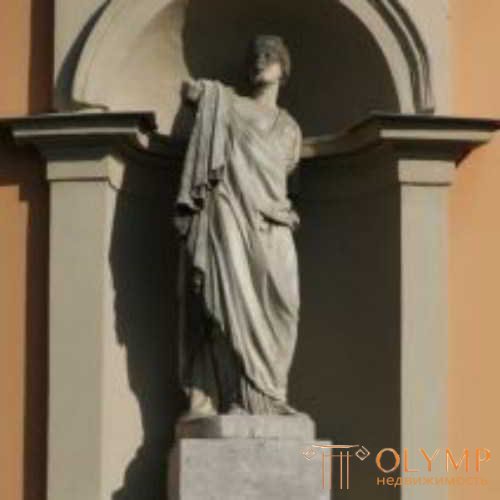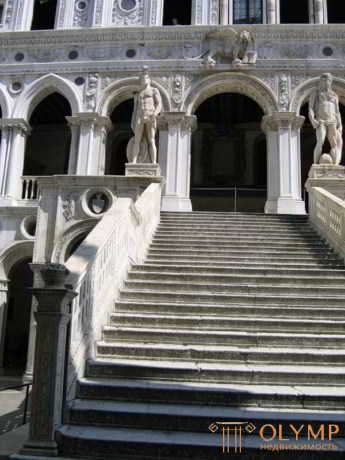
1. The development of sculpture in Upper Italy
In both the XV and the XVI centuries, the sculpture of upper Italy served primarily architectural tasks. The shoots of the old schools made themselves felt here for a long time and in the new age. But in the upper Italy, too, Tuscan sculptors are beginning to dominate. In Bologna, the Florentine Tribolo was joined by a native of Lucca, a pupil of Ferrara Alfonso (Chitadella) Lombardi (about 1497–1537). Here he participated in decorating the elegant right-hand portal of San Petronio with reliefs on biblical scenes, decorated the tympanum of the left portal of this church freely and widely conceived by the marble group of the Resurrection, but then he showed his Upper Italian temperament, whose passionate realism already reveals a transition to the peculiarities of the baroque movement. Such are his terracotta groups in natural growth of the Old-Kolon type, for example, the huge undyed group of the Assumption of Our Lady in Santa Maria della Vita. In Genoa, the beautiful chapel of John the Baptist was decorated with marble statues by such significant Tuscan masters as Matteo Civitala and Andrea Sansovino. However, the restoration of the altar canopy of this chapel, which so successfully connects, according to Suida, “the Lombard taste in the ornament with the simplified forms of the sixteenth century style”, was performed mainly by the Lombards, Giovanni Giacomo and his son Guglielmo della Porta (died in 1577) . However, after Guglielmo, who left Genoa to join Rome in the service of Michelangelo, Michelangelo’s most devoted student, Montorsoli, a tuscan, came here and, on instructions from Andrea Doria, performed his colossal statue, later destroyed, and in the altar niche of San Matteo, moreover, Piet’s group, between the apostles and the prophets, then the full figure of the Savior with the reliefs of the prophets and evangelists on the sides. Among the sculptors who decorated the palace of Andrea Doria, stood the Tuscan Giovanni da Fiesole, who performed not only the beautiful main portal, but also two huge and majestic fireplaces with large halls with sculptural decoration. Thus, Tuscan sculpture fully conquered Genoa.
In Milan, the old Lombard style was manifested, although independently, but without much grandeur in the fine works of Agostino Busti, called Bambaya (1480-1548). Brilliant representatives of it in the transition to the XVI century were Giovanni Antonio Amadeo and Cristoforo Solari il Gobbo. The main works of Busti, like the monuments of Gaston de la Foix (1515–1522), or the names of Birago (after 1522), unfortunately, are destroyed, their parts, as Sant Ambrogio has shown, are scattered in different collections. A purely gravestone figure of Gaston graces the Museum of the Castle in Milan. In the style of Michelangelo and in the spirit of Cellini, Padoans Leon Leoni (1509–1590) and his son Pompeo Leoni (died in 1610) also worked in Milan (Plone dedicated a separate work). The marble tombstone of Giovanni Giacomo de Medici in the Cathedral of Milan is a pale imitation of Michelangelo. The sitting bronze figure of Vincenzo Gonzaga on his monument in Sabionetta is more expressive. However, father and son developed their main activity in the field of bronze busts, statuettes and medals, which they produced not only for the Italian rulers, but also for Charles V and Philip II Museum in Madrid, the Court Museum in Vienna and Windsor Castle are rich in works their works, through which the Starolombard sculpture seeks and finds contact with the world baroque style in the field of applied art.
In Venice, next to the style of this early Renaissance, their own, clearly based on antiquity, not yet brought to internal unity and exaggerated style of high Renaissance, were established by the sons of Pietro Lombarda, Tullio and Antonio Lombardi, of whom Tullio worked until 1632. The true high Renaissance introduced and in the Venetian sculpture only Florentine Jacopo Sansovino. Subjecting to the property of the tasks assigned to her, the sculpture by Jacopo in Venice undoubtedly became more superficial and decorative, but even after 1550 she kept away from exaggerations of the Michelangean style and quite often pleases with the fresh vitality of her figures and their movements. Bronze statues of Apollo, Mercury, Minerva and the Goddess of Peace in niches belong to his best works, then marble reliefs of mythological content, for example, relief with Friks and Gela, located on the basement of a marble gallery (Loggetti) near the collapsed bell tower of San Marco. His reliefs and heads on the frames of the bronze door of the sacristy of the cathedral of St. Mark. Of his gravestones, the most beautiful monument of Doge Venier in San Salvatore, and on it the statue of “Hope”, insignificant in its originality, but most famous in the circles of the classical direction. Later colossal marble statues of Mars and Neptune Jacopo, which gave the name "The Ladder of the Giants" in the courtyard of the Doge's Palace, give the impression of lush plastic phrases.

Fig. 41. Statue of "Hope"

Fig. 42. The stairs of the giants
Of the many students who gathered near Jacopo Sansovino in Venice, whom he gave in his larger enterprises, for example, in the sculptural decoration of the Library, the Doge and Loggetta Palace, Danese Cattaneo of Carrara (1509–1573) is in his portrait busts of Bembo and Contarini Cathedral St. Anthony in Padua is less cloying and calculated than in his ideal works, what are the statues on the tomb of Loredano in Santi Giovanni and Paolo in Venice. Alessandro Vittoria from Trient (1525–1608) makes a fresher and more truthful impression with her own bust in San Zaccaria in Venice than with her elongated church statues with mannered movements, not excluding the beautiful figure of St. Sebastian at San Salvatore in Venice. On the contrary, for the last quarter of the 15th century, Venice was decorated for its time by a talented master, a student of Cattaneo, Girolamo Campania from Verona (died about 1550), clean in style, although designed for effect, with numerous marble and bronze statues. As a religious master of his shows a bronze group in San George Maggiore, representing the Savior on the globe, supported by kneeling angels. As a secular master, he is characterized by the fireplace figures of Mercury and Hercules in the Hall of the Colleagues of the Doge’s Palace, and as a portrait master, the gravestone figure of the dozing Doge of Chichony in the Jesuit church gives an excellent concept. Girolamo Campana also finished (in 1577) the last of the large marble reliefs from the life of St.. Anthony in the Padua chapel of the saint, worked on by the most prominent Venetian masters from the beginning of the 16th century, first Antonio and Tullio Lombardo, then Jacopo Sansovino, whose relief, representing the resurrection of the dead, yields to Campania's similar relief in clarity and naturalness. In general, these nine large marble reliefs in Santo, in Padua, belong to the most important manifestations of the narrative sculpture of the XV and XVI centuries; only the proximity of Donatello's immortal bronze reliefs on the main altar of the church makes them seem cold and empty, despite their beauty.
One of the most independent Upper Italian sculptors of the XVI century was, then, Antonio Begarelli from Modena (1479–1565), with an independent understanding of nature, he transferred to the field of plastic beauty of the XVI century, devoid of colors, the lush terracotta groups Siegfried Weber. His calmly composed “Lamentation of the Body of Christ” (1544–1546) in San Pietro, and the excellent bust of Sigonio (1555) in Sant'Agostino in Modena give the impression of greater maturity than the pathetic “Crying over the Body of Christ” begun in 1524 in Sant'Agostino (1531–1537) and rich in figures, but somewhat helplessly compiled “Descent from the Cross” (1544–1547) in San Francesco. The influence of Correggio, the great painter of nearby Parma, is reflected in the expressiveness of his heads. With his flattering clothes, Begarelli, however, foreshadows the more dispersed art of the future. Michelangelo’s follower in these places is Prospero Clementi of Reggio (1500–1584), whose statues in the Mauden castle already give surface forms; however, his best work, the tombstone of Bishop Rangoni in Reggio Cathedral, in the majestic seated figure of the deceased reveals more direct observation and natural feeling. Soon afterwards, the sculpture of upper Italy was captured by a whirlpool of new style, full of movement.
Что бы оставить комментарий войдите
Комментарии (0)